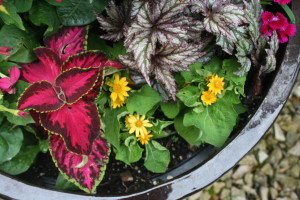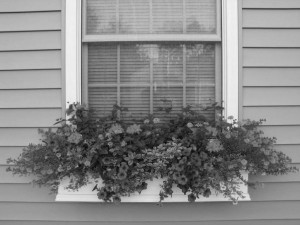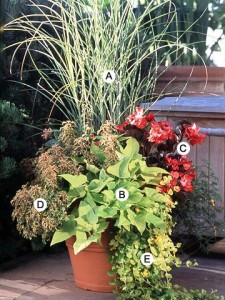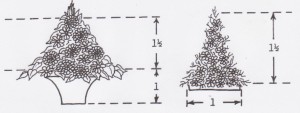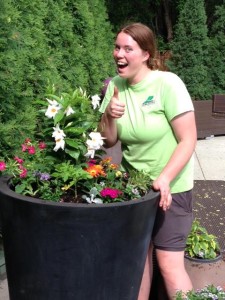
Containers are a fun and easy way to try your hand at gardening. There are no hard and fast rules for successful container gardening so feel free to take a few risks and experiment. That being said, here a few tips and suggestions that may help steer you away from problems:
1. Use annuals!
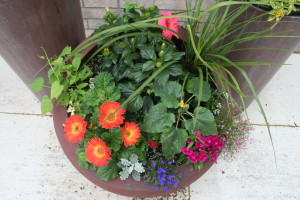
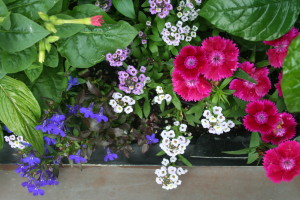 There are two major divisions in garden plants: annuals and perennials. Annuals can only be used for one year (meaning they will die in our Minnesota winters). Perennials will come back year after year if they are planted in the ground (but plants don’t typically survive our winters if they’re left outside in pots). For this reason, perennials are more expensive than annuals. And why buy a more expensive plant that you can only use for one year
There are two major divisions in garden plants: annuals and perennials. Annuals can only be used for one year (meaning they will die in our Minnesota winters). Perennials will come back year after year if they are planted in the ground (but plants don’t typically survive our winters if they’re left outside in pots). For this reason, perennials are more expensive than annuals. And why buy a more expensive plant that you can only use for one year
Garden centers make this easy by keeping annuals and perennials in separate sections.
2. Pay attention to the plant tags!
Every plant you buy should have a tag on the pot or in the soil that tells you its name as well as its growing requirements. This will tell you how much sun, water, and fertilizer the plant needs. Don’t try to grow a plant that needs full sun in a shady spot – the plant will not grow well and you will be disappointed.
Likewise, it’s best to put plants together that have similar needs. If the tag says that one of your plants needs a lot of water and another of your plants prefers to be hot and dry then you should avoid putting them in the same pot. You won’t be able to keep both plants happy!
3. Use contrasting colors and textures!
This is just a guideline but I prefer to choose plants with various colors and textures. You’re going to have this container for the whole season – you don’t want to get bored with it by July so make it exciting!
Color: Don’t just pay attention to the flower color. The plant probably won’t have flowers all the time so make sure you like the color of the leaves. There are many red, purple, yellow, and variegated (multi-colored) leaves to choose from. And don’t discount the many different shades of green when making your selection!
Texture: Sometimes it can be hard to put your finger on why you prefer one container arrangement over another. I find that a mix of interesting textures makes the difference between a nice design and one that is truly eye-catching!
Here’s an easy way to see the difference:
This window box is overflowing with a fun mix of colors for the flowers but take a look at it in black and white:
There’s not a lot of variety in textures here, the leaves and flowers are about the same size and without color it’s hard to tell one plant from another.
Now take a look at this arrangement from Better Homes and Garden:
Now in black and white:
Can you see the contrast between feathery texture of the grass (A), the coarser texture of the sweet potato vine (B), and the very fine texture of coleus (D)? Even without color each plant has a distinct look.
4. Proportion and Basic Design
There are three basic roles you want you want your plants to fill: height (vertical element), mass, and depth (trailing element). This arrangement also has great examples for each of these roles:
This arrangement has a tall, vertical element in the back (A). Colorful and varied textures forming the bulk of the mass in the middle (B, C, D), and trailing element in the front (E).
While filling these roles you want to make sure you don’t make the arrangement feel top heavy or out of proportion. Typically you want your arrangement to be about 1.5 times the height of your container. If you have a short, squat container then you want your arrangement to be about 1.5 times the width. Sound confusing? Take a look at the diagram below:
5. Have fun!
Remember – these are tips and guidelines, not rules! Don’t be afraid to try something new and if it doesn’t work you can try something different the next year. You can always remove problematic plants and replace them with something new anytime during the season.
Happy gardening!
For more information on container gardening be sure to check out some of our other articles:
Container Gardening: Choosing Your Container
4 Easy Maintenance Tips for a Beautiful Container Garden
Looking for ideas? Check out our Container Garden board on Pinterest: http://www.pinterest.com/petersonlawn/container-gardening/
Want to enjoy some containers but don’t have the time to design your own? Call or email Annika and let her take care of it for you!
Office: 952-252-3301
Email: Annika@PetersonLawn.com
Annika is the horticulturalist at Peterson Lawn Services. Call (952) 929-0422 to schedule a free garden consultation today!
Looking for fun gardening ideas – not sure where to start? Check out our Pinterest page: http://www.pinterest.com/petersonlawn/
Be sure to “Like” us on Facebook: https://www.facebook.com/petersonlawnservices

